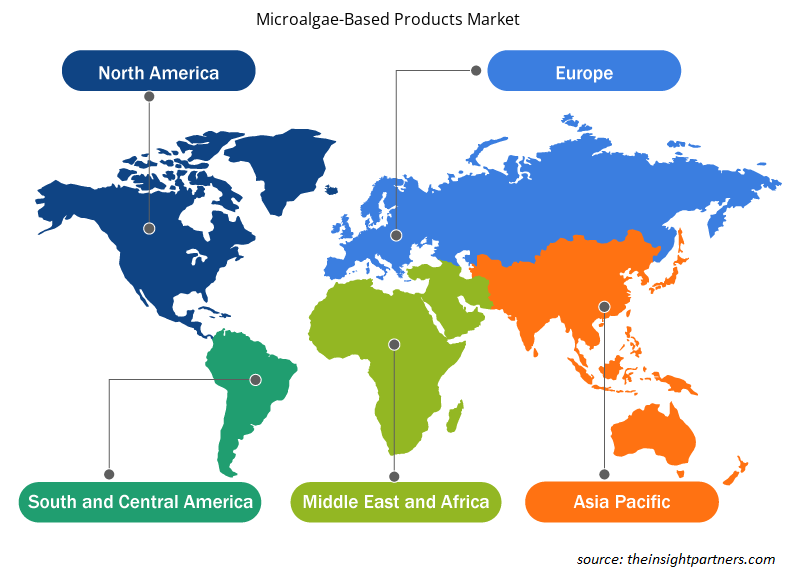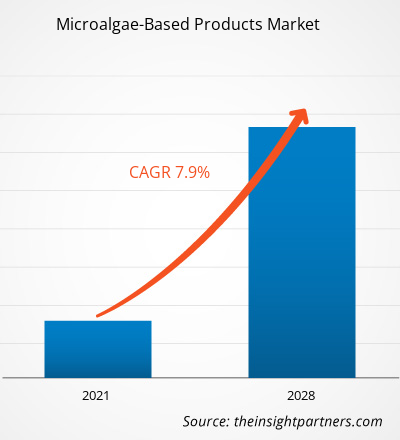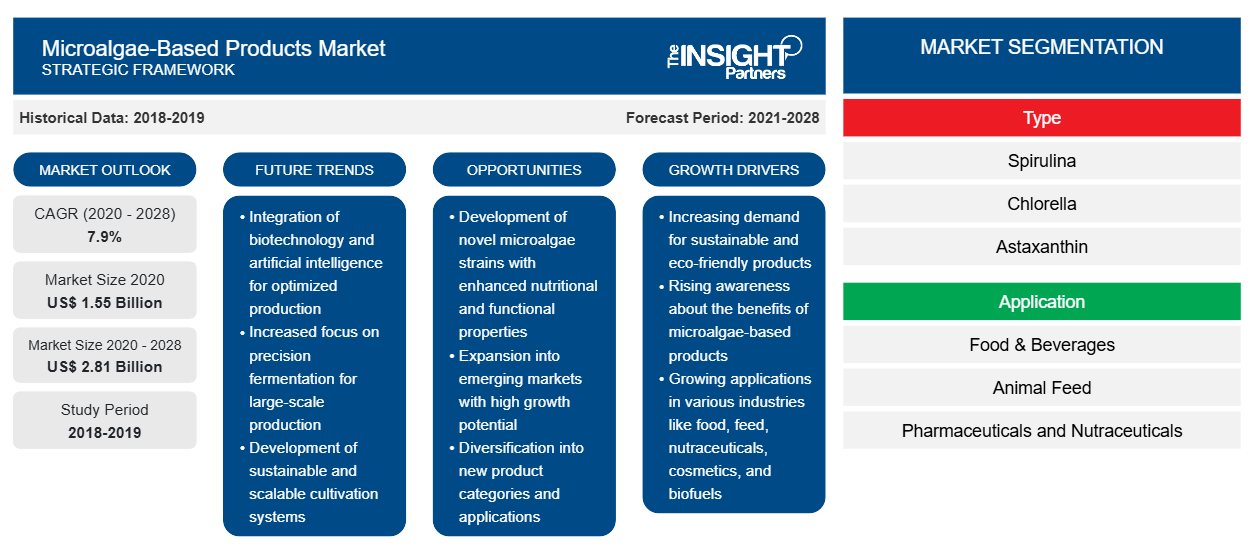Il mercato dei prodotti a base di microalghe è stato valutato 1.547,23 milioni di dollari nel 2020 e si prevede che raggiungerà i 2.811,10 milioni di dollari entro il 2028; si prevede una crescita a un CAGR del 7,9% dal 2021 al 2028.
Le microalghe sono definite come microrganismi procarioti o eucarioti che possono essere tracciati con l'aiuto di un microscopio. Questi organismi microscopici sono specie unicellulari che si trovano separatamente o in catene o gruppi e possono essere reperiti da sistemi di acqua dolce e marina. Questi microrganismi possiedono una struttura cellulare semplice e necessitano di luce, anidride carbonica, acqua e nutrienti essenziali come fosforo e azoto per la loro crescita. Inoltre, le microalghe sono una fonte di sostanze fitochimiche vitali come carotenoidi, fibre, minerali, antiossidanti, acidi grassi, vitamine, composti alogenati, polisaccaridi, proteine e lectina. Le microalghe sono considerate una preziosa fonte di biomassa che ritrae diverse potenziali applicazioni in numerosi settori. Ad esempio, le microalghe trovano applicazione in diversi settori di utilizzo finale come alimenti e bevande, nutrizione animale, prodotti farmaceutici e nutraceutici e cura della persona.
Nel 2020, l'Europa ha contribuito alla quota maggiore del mercato globale dei prodotti a base di microalghe . Il predominio del mercato dei prodotti a base di microalghe in questa regione è attribuibile principalmente alla presenza di una solida base industriale con importanti produttori di prodotti farmaceutici e nutraceutici, nonché di alimenti e bevande confezionati. L'elevata domanda di prodotti a base di microalghe da varie applicazioni come alimenti e bevande, mangimi per animali, prodotti farmaceutici e nutraceutici, cura della persona, prodotti chimici e biocarburanti sta stimolando la crescita del mercato in Europa. I crescenti investimenti nelle tecnologie di coltivazione, insieme a una crescente attenzione alle soluzioni sostenibili, offrono opportunità redditizie per la crescita del mercato dei prodotti a base di microalghe nella regione.
Personalizza questo report in base alle tue esigenze
Riceverai la personalizzazione gratuita di qualsiasi report, comprese parti di questo report, o analisi a livello nazionale, pacchetto dati Excel, oltre a usufruire di grandi offerte e sconti per start-up e università
-
Scopri le principali tendenze di mercato in questo rapporto.Questo campione GRATUITO includerà analisi di dati che spaziano dalle tendenze di mercato alle stime e alle previsioni.
Impatto della pandemia di COVID-19 sul mercato dei prodotti a base di microalghe
La pandemia in corso ha drasticamente alterato lo stato del settore alimentare e delle bevande e ha avuto un impatto negativo sulla crescita del mercato dei prodotti a base di microalghe. L'implementazione di misure per combattere la diffusione del virus ha aggravato la situazione e ha influenzato la crescita di diversi settori industriali. Il mercato è stato influenzato dalla brusca distorsione delle efficienze operative e dalle interruzioni nelle catene del valore attribuibili alla chiusura improvvisa dei confini nazionali e internazionali. Le interruzioni in termini di approvvigionamento di materie prime dai fornitori e le chiusure temporanee delle basi di produzione dovute a blocchi indefiniti e restrizioni di viaggio hanno avuto un impatto sulla crescita del mercato durante la pandemia. Tuttavia, per quanto la pandemia abbia influenzato le operazioni della catena di fornitura, ha anche spostato l'attenzione dei consumatori verso uno stile di vita sano, per cui i consumatori hanno rivolto la loro attenzione ai prodotti alimentari nutrizionali. Inoltre, si prevede che la crescente domanda di prodotti a base di microalghe nei settori alimentare e delle bevande, farmaceutico e nutraceutico, mangimi per animali e altri settori, insieme a significativi investimenti da parte di importanti produttori, guiderà il mercato dei prodotti a base di microalghe. Oltre a questo, sono state identificate diverse applicazioni delle microalghe nel trattamento della pandemia di COVID-19. Ad esempio, uno studio pubblicato da Frontiers Media SA nel novembre 2020 dimostra l'efficacia dei metaboliti bioattivi ottenuti dalle microalghe nel trattamento dell'infezione virale simile a SARS-CoV-2. microalgae-based products market. The implementation of measures to combat the spread of the virus has aggravated the situation and affected the growth of several industrial sectors. The market has been impacted by the sudden distortion in operational efficiencies and disruptions in the value chains attributable to the sudden closure of national and international boundaries. Disruptions in terms of sourcing of raw materials from suppliers and temporary closures of manufacturing bases due to indefinite lockdowns and travel restrictions have impacted the growth of the market during the pandemic. However, as much as the pandemic has affected the supply chain operations, it has also shifted the focus of consumers toward healthy living, owing to which, the consumers have turned their attention toward nutritional food products. Additionally, the expanding demand for microalgae-based products across food & beverages, pharmaceuticals and nutraceuticals, animal feed, and other industries, along with significant investment by prominent manufacturers, is expected to drive the microalgae-based products market. Other than this, several applications of microalgae have been identified in the treatment of the COVID-19 pandemic. For instance, a study published by Frontiers Media S.A. in November 2020, demonstrates the efficacy of Bioactive Metabolites obtained from microalgae in the treatment of SARS-CoV-2 like viral infection.
Approfondimenti di mercato
Aumento della domanda di microalghe nelle applicazioni farmaceutiche e nutraceuticheMicroalgae in Pharmaceutical and Nutraceutical Applications
I prodotti a base di microalghe hanno ricevuto lo status di generalmente riconosciuto come sicuro (GRAS), che li rende adatti per applicazioni farmaceutiche e nutraceutiche. Le microalghe sono note per le loro attività antibatteriche, antiossidanti, antivirali, antimalariche, antimicotiche, antitumorali e antinfiammatorie. Sono una fonte di fitochimici vitali come carotenoidi, fibre, minerali, antiossidanti, acidi grassi, vitamine, composti alogenati, polisaccaridi e lectine e altre proteine. Ad esempio, gli acidi grassi polinsaturi (PUFA) presenti nelle microalghe sono potenziali agenti terapeutici che riducono al minimo il rischio di disturbi cronici come disturbi cardiovascolari, malattie diabetiche, morbo di Alzheimer e problemi alla retina. Allo stesso modo, i cianobatteri (alghe verdi-azzurre) vengono sempre più utilizzati nella sintesi di antibiotici e composti farmacologicamente attivi. Allo stesso modo, l'uso dei cianobatteri (alghe verdi-azzurre) è stato esteso alla preparazione di antibiotici e composti farmacologicamente attivi. Inoltre, diversi studi di ricerca affermano l'importanza del consumo di compresse di Chlorella nel trattamento di nausea, vomito e altri problemi gastrointestinali. Allo stesso modo, la carragenina delle alghe rosse aiuta nel trattamento del virus dell'influenza. Inoltre, le alghe sono considerate un'importante fonte di prodotti naturali farmacologicamente attivi e nutraceutici. I prodotti naturali ricavati da diverse varianti di alghe servono come base per la scoperta di farmaci e trovano applicazioni nella formulazione di medicinali. La potenziale applicazione delle microalghe è stata anche determinata nel settore nutraceutico. Attualmente, il valore dei nutraceutici ricavati dalla biomassa algale è molto alto sul mercato. Le microalghe possono essere utilizzate in modo significativo nella preparazione di integratori alimentari, integratori alimentari e alimenti trasformati a valore aggiunto, nonché integratori non alimentari come compresse e softgel. Ad esempio, le microalghe ottenute da clorella, dunaliella, haematococcus, spirulina e aphanizomenon sono ampiamente utilizzate nella preparazione di integratori alimentari. Quindi, c'è un aumento della domanda di microalghe in basi di applicazione farmaceutiche e nutraceutiche. products have received the generally recognized as safe (GRAS) status, which makes them suitable for pharmaceutical and nutraceutical applications. Microalgae are known for their antibacterial, antioxidant, antiviral, antimalarial, antifungal, antitumor, and anti-inflammatory activities. They are a source of vital phytochemicals such as carotenoids, fibers, minerals, antioxidants, fatty acids, vitamins, halogenated compounds, polysaccharides, and lectins and other proteins. For instance, polyunsaturated fatty acids (PUFA) present in microalgae are potential therapeutic agents that also minimize the risk of chronic disorders such as cardiovascular disorders, diabetic diseases, Alzheimer’s disease, and retinal problems. Similarly, cyanobacteria (blue-green algae) are increasingly being used in the synthesis of antibiotics and pharmacologically active compounds. Similarly, the use of cyanobacteria (blue-green algae) has been extended across the preparation of antibiotics and pharmacologically active compounds. Also, several research studies state the importance of the consumption of Chlorella tablets in the treatment of nausea, vomiting, and other gastrointestinal issues. Likewise, carrageenan from red algae helps in the treatment of the influenza virus. Also, algae are considered an important source of pharmacologically active natural products and nutraceuticals. The natural products sourced out from different variants of algae serve as a basis for drug discovery and find applications in the formulation of medicines. The potential application of microalgae has also been determined across the nutraceutical industry. At present, the value of nutraceuticals sourced out from algal biomass is very high in the market. Microalgae can be significantly used in the preparation of food supplements, dietary supplements, and value-added processed foods, as well as non-food supplements such as tablets, and soft gels. For instance, microalgae obtained from chlorella, dunaliella, haematococcus, spirulina, and aphanizomenon are extensively used in the preparation of nutritional supplements. Hence, there is a rise in demand for microalgae in pharmaceutical and nutraceuticals application bases.
Tipo Informazioni
In base al tipo, il mercato dei prodotti a base di microalghe è segmentato in spirulina, clorella, astaxantina, beta carotene e altri. Nel 2020, il segmento della spirulina ha dominato il mercato globale dei prodotti a base di microalghe. La spirulina è definita come un cianobatterio procariotico prodotto per servire diverse basi applicative come acquacoltura, prodotti farmaceutici e nutraceutici e coloranti alimentari. Le microalghe sono composte dal 60-70% di proteine, inclusi amminoacidi come leucina, isoleucina e valina, insieme ad altri minerali essenziali come beta-carotene, vitamine del gruppo B, ficocianina, clorofilla e vitamina E. Il profilo nutrizionale offerto dalle alghe le rende un ingrediente ideale da utilizzare in varie basi applicative. Le alghe spirulina sono classificate come un superfood e sono ampiamente coltivate per soddisfare la crescente domanda in diversi settori di utilizzo finale.microalgae-based products market is segmented into spirulina, chlorella, astaxanthin, beta carotene, and others. In 2020, the spirulina segment dominated the global microalgae-based products market. Spirulina is defined as prokaryotic cyanobacterium which is manufactured to serve diverse application bases such as aquaculture, pharmaceuticals and nutraceuticals, and food dyes. The microalgae are composed of 60–70% of protein, including amino acids such as leucine, isoleucine, and valine, along with other essential minerals such as beta-carotene, B vitamins, phycocyanin, chlorophyll, and vitamin E. The nutritional profile offered by the algae makes it an ideal ingredient to be used in various application bases. Spirulina algae are categorized as a superfood item and are widely cultured to meet the expanding demand across diverse end-use industries.
Approfondimenti sulle applicazioni
In base all'applicazione, il mercato dei prodotti a base di microalghe è segmentato in alimenti e bevande, mangimi per animali, prodotti farmaceutici e nutraceutici, cura della persona e altri. Il segmento dei prodotti farmaceutici e nutraceutici ha rappresentato la quota di mercato maggiore nel 2020. Le microalghe sono considerate una delle fonti rinnovabili di composti farmaceutici e classificate tra i composti con stato generalmente riconosciuto come sicuro (GRAS), ideali per essere utilizzati nell'industria farmaceutica. Le microalghe sono utilizzate in modo significativo nella formulazione di farmaci antitumorali, un composto denominato cryptophyci. Inoltre, sono anche utilizzate per produrre neurotossine alcaloidi come saxitossina e polichetide, grazie alle loro caratteristiche antinfiammatorie e antitumorali. Allo stesso modo, microalghe come clorella, dunaliella, haematococcus, spirulina e aphanizomenon sono ampiamente utilizzate nella formulazione di integratori nutraceutici.
I principali attori che operano nel mercato dei prodotti a base di microalghe includono Algae Health Sciences - A BGG company; Cargill Inc.; Cellana Inc.; e Cyanotech Corporation. Le principali aziende implementano fusioni e acquisizioni e strategie di R&S per espandere la propria base di clienti e guadagnare quote di mercato nel mercato globale dei prodotti a base di microalghe, il che consentirebbe loro di espandere la portata del proprio marchio.
Segnala i riflettori
- Tendenze industriali progressive nel mercato dei prodotti a base di microalghe per aiutare gli operatori a sviluppare strategie efficaci a lungo termine
- Strategie di crescita aziendale adottate dai mercati sviluppati e in via di sviluppo
- Analisi quantitativa del mercato dei prodotti a base di microalghe dal 2019 al 2028
- Stima della domanda globale di prodotti a base di microalghe
- Analisi PEST per illustrare l'efficacia degli acquirenti e dei fornitori che operano nel settore
- Sviluppi recenti per comprendere lo scenario competitivo del mercato
- Tendenze e prospettive di mercato, nonché fattori che guidano e frenano la crescita del mercato dei prodotti a base di microalghe
- Assistenza nel processo decisionale evidenziando le strategie di mercato che sostengono l'interesse commerciale, portando alla crescita del mercato
- Dimensioni del mercato dei prodotti a base di microalghe in vari nodi
- Panoramica dettagliata e segmentazione del mercato, nonché dinamiche del settore dei prodotti a base di microalghe
- Dimensioni del mercato dei prodotti a base di microalghe in varie regioni con promettenti opportunità di crescita
In base alla tipologia, il mercato globale dei prodotti a base di microalghe è stato segmentato in Spirulina, Clorella, Astaxantina, Beta-Carotene e altri.
In base all'applicazione, il mercato globale dei prodotti a base di microalghe è stato segmentato in alimenti e bevande, mangimi per animali, prodotti farmaceutici e nutraceutici, cura della persona e altri.
Approfondimenti regionali sul mercato dei prodotti a base di microalghe
Le tendenze regionali e i fattori che influenzano il mercato dei prodotti a base di microalghe durante il periodo di previsione sono stati ampiamente spiegati dagli analisti di Insight Partners. Questa sezione discute anche i segmenti e la geografia del mercato dei prodotti a base di microalghe in Nord America, Europa, Asia Pacifico, Medio Oriente e Africa e America meridionale e centrale.

- Ottieni i dati specifici regionali per il mercato dei prodotti a base di microalghe
Ambito del rapporto di mercato sui prodotti a base di microalghe
| Attributo del report | Dettagli |
|---|---|
| Dimensioni del mercato nel 2020 | 1,55 miliardi di dollari USA |
| Dimensioni del mercato entro il 2028 | 2,81 miliardi di dollari USA |
| CAGR globale (2020 - 2028) | 7,9% |
| Dati storici | 2018-2019 |
| Periodo di previsione | 2021-2028 |
| Segmenti coperti |
Per tipo
|
| Regioni e Paesi coperti |
America del Nord
|
| Leader di mercato e profili aziendali chiave |
|
Densità degli attori del mercato dei prodotti a base di microalghe: comprendere il suo impatto sulle dinamiche aziendali
Il mercato dei prodotti a base di microalghe sta crescendo rapidamente, spinto dalla crescente domanda degli utenti finali dovuta a fattori quali l'evoluzione delle preferenze dei consumatori, i progressi tecnologici e una maggiore consapevolezza dei benefici del prodotto. Con l'aumento della domanda, le aziende stanno ampliando le loro offerte, innovando per soddisfare le esigenze dei consumatori e capitalizzando sulle tendenze emergenti, il che alimenta ulteriormente la crescita del mercato.
La densità degli operatori di mercato si riferisce alla distribuzione di aziende o società che operano in un particolare mercato o settore. Indica quanti concorrenti (operatori di mercato) sono presenti in un dato spazio di mercato in relazione alle sue dimensioni o al valore di mercato totale.
Le principali aziende che operano nel mercato dei prodotti a base di microalghe sono:
- Scienze della salute delle alghe - Una società Bgg
- Astareal Ab
- Bluebiotech International GmbH
- Cargill, Incorporata
- Cellana Inc.
Disclaimer : le aziende elencate sopra non sono classificate secondo un ordine particolare.

- Ottieni una panoramica dei principali attori del mercato dei prodotti a base di microalghe
Profili aziendali
- Algae Health Sciences - Una società BGG
- Bluebiotech International GmbH
- Cargill Inc
- Cellana Inc
- Nutrizione Earthrise, LLC
- EID - Parry (India) Limited
- Società Cyanotech
- Euglena Co., Ltd
- Far East Bio-Tec Co., Ltd
- AstaReale
- Analisi storica (2 anni), anno base, previsione (7 anni) con CAGR
- Analisi PEST e SWOT
- Valore/volume delle dimensioni del mercato - Globale, Regionale, Nazionale
- Industria e panorama competitivo
- Set di dati Excel
Report recenti
Testimonianze
Motivo dell'acquisto
- Processo decisionale informato
- Comprensione delle dinamiche di mercato
- Analisi competitiva
- Analisi dei clienti
- Previsioni di mercato
- Mitigazione del rischio
- Pianificazione strategica
- Giustificazione degli investimenti
- Identificazione dei mercati emergenti
- Miglioramento delle strategie di marketing
- Aumento dell'efficienza operativa
- Allineamento alle tendenze normative























 Ottieni un campione gratuito per - Mercato dei prodotti a base di microalghe
Ottieni un campione gratuito per - Mercato dei prodotti a base di microalghe